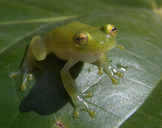|
Hyalinobatrachium orientale (Rivero, 1968)
Eastern Glass Frog | family: Centrolenidae subfamily: Hyalinobatrachinae genus: Hyalinobatrachium |
| Species Description: Rivero, J. A. (1968). "Los centrolénidos de Venezuela (Amphibia, Salientia). Memoria." Sociedad de Ciencias Naturales La Salle. Caracas 28: 301-334. | |
 © 2008 César L. Barrio Amoros (1 of 3) |
|
|
|
Distribution and Habitat Country distribution from AmphibiaWeb's database: Trinidad and Tobago, Venezuela
Life History, Abundance, Activity, and Special Behaviors This nocturnal species has both arboreal and terrestrial ecomorphs and are commonly found along freshwater streams and vegetation in forested wetlands (IUCN 2020). Hyalinobatrachium orientale resides near streams due to reproductive needs, such as laying eggs on leaves above water (Jowers et al. 2014). Reproductive adults and egg clutches are most abundant during the wet seasons with frequent rainfall. Adults prefer to reproduce and lay egg clutches in turbid and fast-moving water, as the high water flow can decrease fish predation on egg clutches, making it the best time for breeding season (Nokhbatolfoghahai et al. 2015). The courtship and oviposition behavior of H. orientale lasts approximately five hours, from when the female responds to the male call and ending after oviposition. Prior to oviposition, the female evaluates the quality of the male and the reproductive site, a Heliconia leaf. After the female choose a male, he then grasps her in amplexus and they position themselves around both sides of the leaf's surface, signaling the start of oviposition. After oviposition the male stays with the egg clutch and the female leaves (Nokhbatolfoghahai et al. 2015). Average clutch size ranges from 23 - 32 eggs, each with an average diameter of 1.86 mm (Nokhbatolfoghahai et al. 2015). Egg masses of this species can be found primarily on the underside of Heliconia leaves above small streams. Embryos, tadpoles, and eggs can be found on fallen Heliconia leaves near stream banks. If the Heliconia leaves are not present, Philodendron leaves and palms have been reported to be used too (Lehtinen and Georgiadis 2012). The egg development timeline is heavily influenced by different factors such as egg size and temperature, flooding, and predation by arthropods. Therefore, male parental care is critical to the survival of the eggs. Males sit on their eggs to prevent desiccation, protect eggs from insect predation, and infection, all while emitting alarm calls in response to the predation as needed (Murphy et al. 2012). A study researching egg development found brooding behavior exhibited by the male parent to hydrate the eggs contribute to a longer hatch time (Delia et al. 2014). Trends and Threats Possible reasons for amphibian decline General habitat alteration and loss
References
Byrne, I., Thomson, R., Thomson, R., Murry-Uren, D., Downie, J.R. (2020). “Observations on metamorphosing tadpoles of Hyalinobatrachium orientale (Anura: Centrolenidae).” Phyllomedusa: Journal of Herpetology, 19(2): 217-223. [link] Castroviejo-Fisher, S., Señaris, J.C., Ayarzagüena, J., Vilà, C. (2008). “Resurrection of Hyalinobatrachium orocostale and notes on the Hyalinobatrachium orientale species complex (Anura: Centrolenidae).” Herpetologica, 64(1): 472–484. [link] Delia, J. R. J., Ramirez-Bautista, A., Summers, K. (2014). "Glassfrog embryos hatch early after parental desertion." Proceeding of the Royal Society B 281: 2013–3237 [link] IUCN SSC Amphibian Specialist Group. (2020). "Hyalinobatrachium orientale." The IUCN Red List of Threatened Species 2020: e.T43268296A3022366. https://dx.doi.org/10.2305/IUCN.UK.2020-3.RLTS.T43268296A3022366.en. Accessed on 08 March 2022. Jowers, M.J., Lehtinen, R.M., Downie, R.J., Georgiadis, A.P, Murphy, J.C. (2014) “Molecular phylogenetics of the glass frog Hyalinobatrachium orientale (Anura: Centrolenidae): evidence for Pliocene connections between mainland Venezuela and the island of Tobago.” Mitochondrial DNA 26(4): 613-618 [link] Lehtinen, R. M., Georgiadis, A.P. (2012). “Observations on parental care in the glass frog Hyalinobatrachium orientale (Anura: Centrolenidae) from Tobago, with comments on its natural history.” Phyllomedusa: Journal of Herpetology, 11(1): 75-77 [link] Murphy, J.C., Charles, S., Traub, J. (2012). “Hyalinobatrachium orientale: Male parental care.” Herpetological Review 43:118-119. Nokhbatolfoghahai, M., Pollock, C.J., Downie, J.R. (2015). "Oviposition and development in the glass frog Hyalinobatrachium orientale (Anura: Centrolenidae)." Phyllomedusa: Journal of Herpetology, 14(1), 3-17 [link] Originally submitted by: Casalena Len, Alessandra Campos, Sophia Leung (2022-04-06) Distribution by: Casalena Len, Alessandra Campos, Sophia Leung (updated 2022-04-06)
Life history by: Casalena Len, Alessandra Campos, Sophia Leung (updated 2022-04-06)
Trends and threats by: Casalena Len, Alessandra Campos, Sophia Leung (updated 2022-04-06)
Edited by: Ann T. Chang (2022-04-06) Species Account Citation: AmphibiaWeb 2022 Hyalinobatrachium orientale: Eastern Glass Frog <https://amphibiaweb.org/species/1819> University of California, Berkeley, CA, USA. Accessed Nov 29, 2024.
Feedback or comments about this page.
Citation: AmphibiaWeb. 2024. <https://amphibiaweb.org> University of California, Berkeley, CA, USA. Accessed 29 Nov 2024. AmphibiaWeb's policy on data use. |




 Map of Life
Map of Life